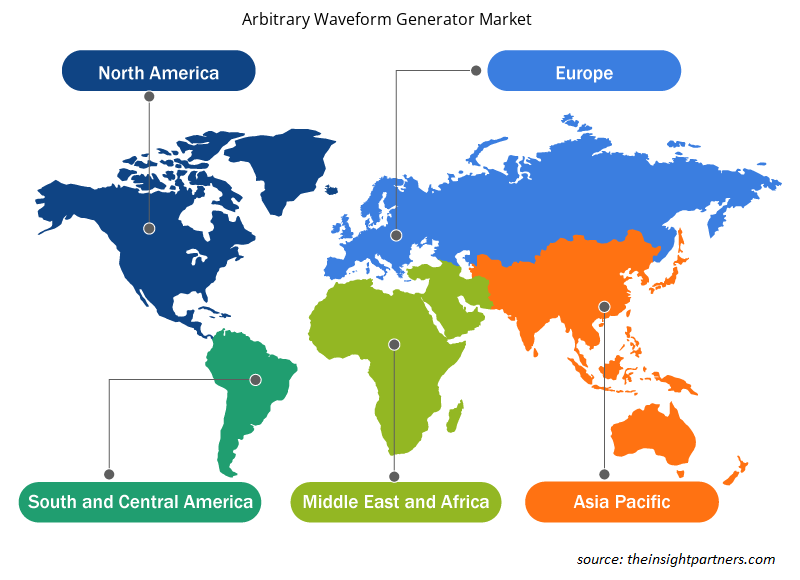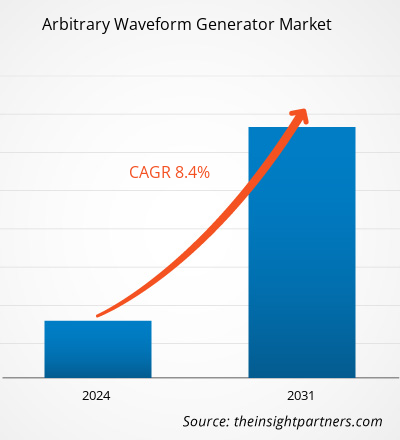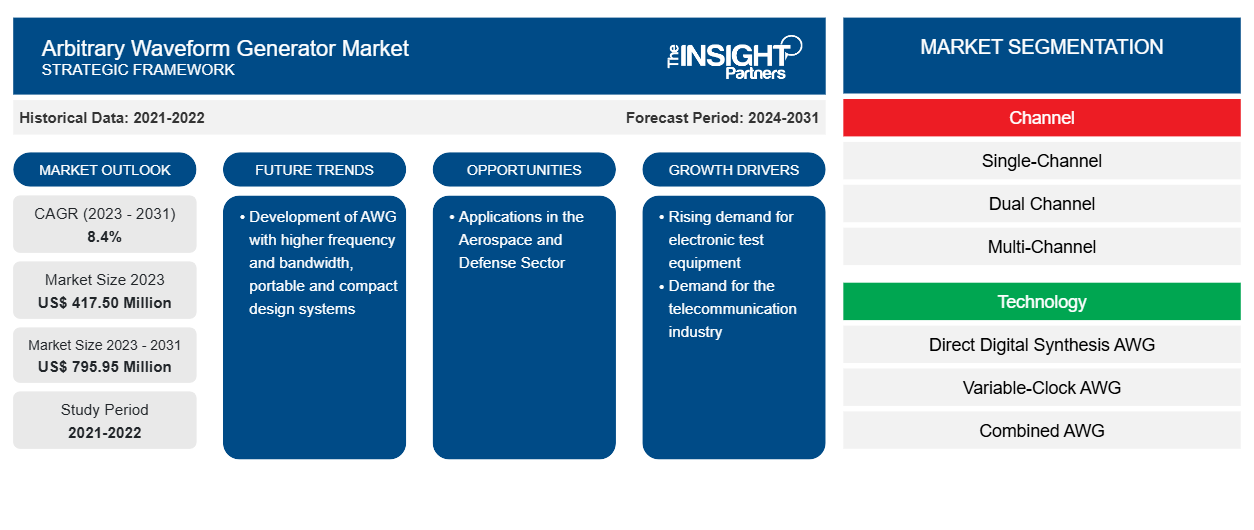La taille du marché des générateurs de formes d'ondes arbitraires devrait atteindre 795,95 millions USD d'ici 2031, contre 417,50 millions USD en 2023. Le marché devrait enregistrer un TCAC de 8,4 % au cours de la période 2023-2031. Le développement d'AWG avec une fréquence et une bande passante plus élevées et des systèmes de conception portables et compacts devrait rester une tendance clé du marché.
Analyse du marché des générateurs de formes d'ondes arbitraires
Lorsque des problèmes de mesure se posent et nécessitent des signaux de commande plus complexes que les signaux périodiques classiques, les générateurs de formes d'ondes arbitraires (AWG) apportent une réponse. Les AWG sont utilisés dans de nombreuses applications qui nécessitent des formes d'ondes spécifiques. On les retrouve dans un large éventail de domaines de l'industrie électronique. Grâce à leur grande flexibilité, les générateurs de formes d'ondes arbitraires modernes peuvent produire des formes d'ondes extrêmement spécifiques qui peuvent être utilisées pour tester une large gamme d'applications. Les AWG sont fréquemment utilisés dans les oscilloscopes numériques contemporains.
Aperçu du marché des générateurs de formes d'ondes arbitraires
Avec la complexité croissante des secteurs de l'électronique, des semi-conducteurs et des télécommunications, il existe un besoin croissant de divers équipements de test, tels que le générateur de formes d'ondes arbitraires, pour tester la fonctionnalité de l'équipement. Avec la prolifération de la 5G et le développement continu de l'infrastructure des télécommunications, l'AWG joue un rôle essentiel dans le développement des systèmes de communication et le test du traitement du signal.
Personnalisez ce rapport en fonction de vos besoins
Vous bénéficierez d'une personnalisation gratuite de n'importe quel rapport, y compris de certaines parties de ce rapport, d'une analyse au niveau des pays, d'un pack de données Excel, ainsi que d'offres et de remises exceptionnelles pour les start-ups et les universités.
- Obtenez les principales tendances clés du marché de ce rapport.Cet échantillon GRATUIT comprendra une analyse de données, allant des tendances du marché aux estimations et prévisions.
Moteurs et opportunités du marché des générateurs de formes d'ondes arbitraires
La demande croissante en équipements de test électroniques devrait favoriser le marché
Les équipements de test et de mesure électroniques (T&M) sont en pleine croissance, stimulés par les nouvelles normes numériques à haut débit, les centres de données, la conduite autonome, la 5G, l'Internet des objets (IoT) et les applications énergétiques. Les technologies qui évoluent dans les différentes étapes du développement, de la fabrication et du déploiement du cycle de vie des produits ont déclenché la prochaine vague de croissance. La demande va augmenter dans tous les secteurs verticaux en raison de la complexité accrue et de la convergence technologique, les secteurs industriel et automobile connaissant la plus forte croissance et les secteurs des communications, des semi-conducteurs et de l'informatique offrant les plus grandes perspectives. Compte tenu des limites physiques des instruments de test actuels, les vitesses de transmission ne peuvent pas répondre à la demande croissante de débits de transfert de données plus rapides dans les télécommunications et les centres de données. Cela a conduit à une augmentation du besoin du marché en générateurs de formes d'ondes arbitraires.IoT), and power applications. The lifecycle development, manufacture, and deployment have started the next wave of growth. Demand will increase across all verticals due to increased complexity and technological convergence, with the industrial and automotive verticals seeing the greatest growth and the communications, semiconductor, and computer industries offering the biggest prospects. With the current test instruments' physical limits, transmission speeds cannot keep up with the increasing demand for faster data transfer rates in telecom and data centers. This has led to an increase in the market's need for arbitrary waveform generators.
Applications dans le secteur aérospatial et de la défense
Pour confirmer que leur radar traite correctement les cibles et pour évaluer l'efficacité de la bande de base pour transmettre les micro-ondes dans la chaîne de conversion, les concepteurs de systèmes radar doivent fournir des formes d'onde de test. Le JTRS exige des transmissions agiles en fréquence à bande étroite pour les systèmes de communication. Les concepteurs de systèmes de communication par satellite doivent faire face à des bandes passantes d'information en expansion. Les concepteurs doivent produire des signaux haute fidélité en plus de simuler des formes d'onde de référence pour toutes ces applications, ce qui nécessite un générateur de formes d'onde arbitraires à large bande. Les principales applications émergentes de l'AWG dans le secteur de l'aérospatiale et de la défense sont les tests radar, les tests satellite, les communications militaires, la simulation d'environnement RF et les tests de récepteurs généraux.baseband to microwave up the conversion chain, radar system designers must provide test waveforms. JTRS demands narrowband frequency agile transmissions for communication systems. The designers of satellite communication systems must deal with expanding information bandwidths. Designers need to produce high-fidelity signals in addition to simulating reference waveforms for all of these applications, which calls for a wideband arbitrary waveform generator. The major emerging applications for AWG in the aerospace and defense sector are Radar tests, satellite tests, military communications, RF environment simulation, and general receiver tests.
Analyse de segmentation du rapport sur le marché des générateurs de formes d’ondes arbitraires
Les segments clés qui ont contribué à la dérivation de l’analyse du marché des générateurs de formes d’ondes arbitraires sont le canal, la technologie, la bande passante et l’application.
- En fonction du canal, le marché des générateurs de formes d'ondes arbitraires est divisé en monocanal, double canal et multicanal. Le segment XX détenait la plus grande part en 2023.
- En fonction de la technologie, le marché est divisé en AWG à synthèse numérique directe, AWG à horloge variable et AWG combiné.AWG, variable-clock AWG, and combined AWG.
- En fonction de la bande passante, le marché est divisé en moins de 1 GHz, 1 à 5 GHz, 5 à 10 GHz, 10 à 25 GHz, 25 à 32 GHz, 32 à 50 GHz et plus de 50 GHz.
- En fonction de l’application, le marché est divisé en télécommunications, éducation, santé, électronique et autres.
Analyse des parts de marché des générateurs de formes d'ondes arbitraires par géographie
La portée géographique du rapport sur le marché des générateurs de formes d’ondes arbitraires est principalement divisée en cinq régions : Amérique du Nord, Asie-Pacifique, Europe, Moyen-Orient et Afrique, et Amérique du Sud et centrale.
L'Amérique du Nord détient une part importante du marché des générateurs de formes d'ondes arbitraires en 2023. La région compte une forte présence d'acteurs clés sur le marché. De plus, le paysage technologique et les investissements dans la R&D et les tests d'équipements complètent encore la croissance des générateurs de formes d'ondes arbitraires sur le marché.
Aperçu régional du marché des générateurs de formes d'ondes arbitraires
Les tendances régionales et les facteurs influençant le marché des générateurs de formes d’ondes arbitraires tout au long de la période de prévision ont été expliqués en détail par les analystes d’Insight Partners. Cette section traite également des segments et de la géographie du marché des générateurs de formes d’ondes arbitraires en Amérique du Nord, en Europe, en Asie-Pacifique, au Moyen-Orient et en Afrique, ainsi qu’en Amérique du Sud et en Amérique centrale.

- Obtenez les données régionales spécifiques pour le marché des générateurs de formes d'ondes arbitraires
Portée du rapport sur le marché des générateurs de formes d'ondes arbitraires
| Attribut de rapport | Détails |
|---|---|
| Taille du marché en 2023 | 417,50 millions de dollars américains |
| Taille du marché d'ici 2031 | 795,95 millions de dollars américains |
| Taux de croissance annuel composé mondial (2023-2031) | 8,4% |
| Données historiques | 2021-2022 |
| Période de prévision | 2024-2031 |
| Segments couverts | Par chaîne
|
| Régions et pays couverts | Amérique du Nord
|
| Leaders du marché et profils d'entreprises clés |
|
Densité des acteurs du marché des générateurs de formes d'ondes arbitraires : comprendre son impact sur la dynamique des entreprises
Le marché des générateurs de formes d'ondes arbitraires connaît une croissance rapide, tirée par la demande croissante des utilisateurs finaux en raison de facteurs tels que l'évolution des préférences des consommateurs, les avancées technologiques et une plus grande sensibilisation aux avantages du produit. À mesure que la demande augmente, les entreprises élargissent leurs offres, innovent pour répondre aux besoins des consommateurs et capitalisent sur les tendances émergentes, ce qui alimente davantage la croissance du marché.
La densité des acteurs du marché fait référence à la répartition des entreprises ou des sociétés opérant sur un marché ou un secteur particulier. Elle indique le nombre de concurrents (acteurs du marché) présents sur un marché donné par rapport à sa taille ou à sa valeur marchande totale.
Les principales entreprises opérant sur le marché des générateurs de formes d'ondes arbitraires sont :
- Société de précision B&K
- SOCIÉTÉ NUCLEONIQUE DE BERKELEY
- KEYSIGHT TECHNOLOGIES
- Technologie Pico
- Rohde & Schwarz
- SHF Communication Technologies AG
Avis de non-responsabilité : les sociétés répertoriées ci-dessus ne sont pas classées dans un ordre particulier.

- Obtenez un aperçu des principaux acteurs du marché des générateurs de formes d'ondes arbitraires
Actualités et développements récents du marché des générateurs de formes d'ondes arbitraires
Le marché des générateurs de formes d'ondes arbitraires est évalué en collectant des données qualitatives et quantitatives après des recherches primaires et secondaires, qui comprennent d'importantes publications d'entreprise, des données d'association et des bases de données. Quelques-uns des développements du marché des générateurs de formes d'ondes arbitraires sont répertoriés ci-dessous :
- Berkeley Nucleonics, pionnier dans le domaine de l'instrumentation électronique , a dévoilé son dernier générateur de signaux RF/micro-ondes : le modèle 870A. Cet instrument avancé est conçu pour répondre aux applications les plus exigeantes, offrant des performances exceptionnelles avec une agilité ultra-élevée et un bruit de phase ultra-faible, couvrant une gamme de fréquences impressionnante de 100 kHz à 50 GHz. (Source : Berkeley Nucleonics, communiqué de presse, septembre 2023)
- Keysight Technologies, Inc. (NYSE : KEYS), une société technologique de premier plan qui aide les entreprises, les fournisseurs de services et les gouvernements à accélérer l'innovation pour connecter et sécuriser le monde, a annoncé le premier générateur de formes d'ondes arbitraires (AWG) de 256 Géch/s - le M8199A de Keysight - avec une bande passante analogique de 65 GHz dans un module AXIe compact à 2 emplacements. (Source : Keysight Technologies, Inc, communiqué de presse, septembre 2020)
Rapport sur le marché des générateurs de formes d’ondes arbitraires et livrables
Le rapport « Taille et prévisions du marché des générateurs de formes d’ondes arbitraires (2021-2031) » fournit une analyse détaillée du marché couvrant les domaines ci-dessous :
- Taille et prévisions du marché des générateurs de formes d'ondes arbitraires aux niveaux mondial, régional et national pour tous les segments de marché clés couverts par le champ d'application
- Tendances du marché des générateurs de formes d'ondes arbitraires, ainsi que la dynamique du marché telle que les moteurs, les contraintes et les opportunités clés
- Analyse détaillée des cinq forces de PEST/Porter et SWOT
- Analyse du marché des générateurs de formes d'ondes arbitraires couvrant les principales tendances du marché, le cadre mondial et régional, les principaux acteurs, les réglementations et les développements récents du marché
- Analyse du paysage industriel et de la concurrence couvrant la concentration du marché, l'analyse de la carte thermique, les principaux acteurs et les développements récents pour le marché des générateurs de formes d'ondes arbitraires
- Profils d'entreprise détaillés
- Analyse historique (2 ans), année de base, prévision (7 ans) avec TCAC
- Analyse PEST et SWOT
- Taille du marché Valeur / Volume - Mondial, Régional, Pays
- Industrie et paysage concurrentiel
- Ensemble de données Excel
Rapports récents
Rapports connexes
Témoignages
Raison d'acheter
- Prise de décision éclairée
- Compréhension de la dynamique du marché
- Analyse concurrentielle
- Connaissances clients
- Prévisions de marché
- Atténuation des risques
- Planification stratégique
- Justification des investissements
- Identification des marchés émergents
- Amélioration des stratégies marketing
- Amélioration de l'efficacité opérationnelle
- Alignement sur les tendances réglementaires





















 Obtenez un échantillon gratuit pour - Marché des générateurs de formes d'ondes arbitraires
Obtenez un échantillon gratuit pour - Marché des générateurs de formes d'ondes arbitraires